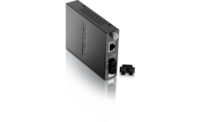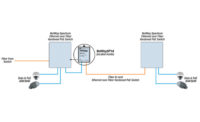Dave’s Cave Cleanout and A New Fiber Optic Splicer

The cleanout results… At least there’s some organization.

After a fusion splice is completed, the splicer provides an estimate of the splice loss based on the way the fiber ends were lined up when fused.

The kit comes with everything you need to perform fiber optic splicing, including a stripping tool and precision cleaver.



I will admit it; I work in a pretty sloppy fashion. While the “bills to be paid” and the “bills to be sent” always get top priority, other items in my business and personal life seem to get magically piled up around my desk and workspace, only to be addressed when desperation occurs.
Due to the small size of my house/office, many of my fiber optic and networking training tools, testers and products end up in the “Dave Cave,” a sloping closet underneath the steps that connect the first floor to the second. Because of the angled ceiling, stuff that gets shoved way back into the closet is rarely seen or used, as I can usually find a reason not to have to remove a whole bunch of stuff to get to some device I haven’t handled in three years.
This “portable” splicer weighs in at about 60 pounds and is a pain to haul, set up and use. It was time for an upgrade.
During the Christmas break I was determined to cleanse the Cave and get my equipment back into some form of order. After throwing out six large black trash bags full of stuff, the Cave took on a more organized look.
One of the items I wanted to toss was my 1984 Siecor fusion splicer, which I used to demonstrate splicing of multimode and singlemode fiber strands and connectors. This “portable” splicer weighs in at about 60 pounds and is a pain to haul, set up and use. It was time for an upgrade.
Coincidentally I was recently contacted by a company called Fiber Optic Resale Corporation, which was offering a new fusion splicer kit called the “EZ Splicer” for the attractive cost of $2,100. For those of you who have priced new fusion splicers in the past, this price is a dramatic reduction from the $5,000 and up device costs that have been prevalent in the past.
So with the end of the year looming (gotta spend the money to get the tax break) I popped for the EZ Splicer and got it shipped to Chicago.
Upon getting the splicer I went through the kit and manual. The first surprise I got was that the kit included a “precision” fiber cleaver. Fiber cleavers are used to prepare fiber ends for splicing and/or connector installation. These tools don’t cut the fiber; they break the glass so that the end of the fiber is 90 degrees flat, plus or minus a degree or two. There are two broad categories of cleavers on the market: inexpensive and “precision.” While an inexpensive cleaver can do the trick, the yield of “good” cleaves is usually less than 90 percent, while a precision cleaver will normally produce acceptable cleaves 99 percent of the time. Because the fiber end is so small — thinner than a human hair — a technician cannot see whether the end of the fiber is properly cleaved. So a precision cleaver is a good investment for a fiber optic termination kit. Precision cleavers normally run in the $500-$800 range, so the inclusion of a high-end cleaver in the EZ Splicer kit is a big plus.
The kit also comes with a quality fiber optic stripping tool, power supply and instructions. The EZ Splicer can be powered with its built-in battery and/or the included plug-in charger.
Once I had sufficiently charged the splicer I was ready to do some testing. Initially I had a few problems which caused me to call tech support in New Hampshire. After using the included little teeny 0.9 mm Allen wrench to adjust the fiber holders I was set to go.
One of the really nice features of the EZ Splicer is that the fiber holding adapters work with strong magnets that are built into the cleaver and the splicer itself. Because of these magnets, no fiber cleave length measurement is necessary; the adapters lock into the cleaver, producing a prepared fiber that is of the correct length. When the 250 or 900 micron adapters (one left and one right) are inserted into the splicer, the magnets lock them into the splicing trays and the fiber ends are magnified and visible in the EZ Splicers miniature video screen. At this point the cleave quality can be checked, and the splicer itself will reject fibers that are excessively dirty or have low-quality cleaved ends.
If the fiber ends look good you just press the “splice” button and the machine takes care of the rest. After welding the two fiber ends together the EZ Splicer performs a “pull apart” test to verify the strength of the fused connection and also provides an estimate of optical loss.
Once a splice is complete the heat shrink protector (which you need to put on before splicing) can be slid over the splice and placed into the oven on the top of the EZ Splicer. Once you press the “oven” key, the heat shrink gets shrunk and the splice is completed and protected.
It is important to understand that this is what is termed a “precision v-groove” fiber optic splicer. It is critical that the fibers be absolutely clean and the v-grooves do not have any dust or dirt in them. If the v-grooves are contaminated the splicer will prompt the user to clean them — a very simple process.
In my extensive experimentation with the EZ Splicer (50+ splices) I found that a standard fiber optic alcohol wipe will work for about four splices, after which a new alcohol wipe should be used and the old one thrown away. Once an alcohol wipe is pulled out of its wrapper the alcohol rapidly evaporates and the wipe becomes unusable.
Having a quality fusion splicer like the EZ Splicer is a definite benefit to those companies that are working with fiber, as it can be used not only to perform mid-span permanent fiber connections but also can be used to fuse on “pigtail” connectors, greatly reducing connector installation time and potential problems.
So the EZ Splicer is a winner, and the Siecor went out in the alley — where someone with a strong back snatched it up within 20 minutes.
Visit the http://www.fiberopticresale.com/ webpage or give them a call at 877-287-7535 to get more information.
Looking for a reprint of this article?
From high-res PDFs to custom plaques, order your copy today!












